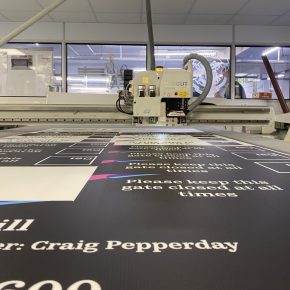
GUEST ARTICLE: The Role of Signage in Construction Waste Reduction
The construction industry is estimated to produce one third of the world’s total waste. With the financial, social and environmental pressures of reducing this figure in mind, Danny Adamson, the Managing Director of Stocksigns, looks at alternative solutions to traditional signage…
It is well-documented that the construction industry contributes to global waste. In the UK alone, a staggering 62% of waste is attributed to construction, with 23% destined for landfill. The urgent need to address this issue has prompted safety signage suppliers to look at how they can help the industry reduce the amount of construction waste it generates.
From the common ‘Construction Site: Keep Out’ to crucial ‘Danger Asbestos’, safety signage is indispensable on a construction site. Unfortunately, these vital signs often contribute to the industry’s waste problem once a project is complete. That is until now.
Through a forward-thinking approach, some signage suppliers are now offering innovative alternatives without compromising the quality of the product.

Closing the loop: recycling in action
Temporary construction signage, manufactured from non-PVC and 100% recyclable materials, is emerging as a game-changer. Once these signs have served their purpose on construction sites, they can be sent to specialist recycling centres instead of going to landfill.
This circular approach effectively eliminates waste and significantly reduces the environmental impact of construction site signage once it is no longer usable or required. Furthermore, the recycled material can be transformed into other products, such as temporary protective flooring, finding a new purpose within the construction industry.
When it comes to construction signage, the traditional cycle of using it and then disposing of it is no longer sustainable. We must start thinking about what happens to these signs once the project is complete.
Partnering for a sustainable future
In order to make the construction industry more sustainable, we need to adapt traditional views about supply chain operations. Instead of seeing suppliers simply as a source of vital resources, we must take a holistic view and appreciate that the environmental actions of manufacturers and suppliers echo up the construction supply chain. To this end, choosing the right supplier to partner with can actively aid your company in meeting environmental targets.
Cutting out construction site wastage by partnering with a supplier that utilises closed-loop systems is on way you lessen your environmental impact, but it is always advisable to investigate the practices, ethics and environmental credentials of all your suppliers before you sign with them.
For contractors, a commitment to sustainability needs to extend beyond just recycling products such as site signs. By choosing suppliers dedicated to closed-loop processes, construction companies can instead contribute to the circular economy and truly mitigate the environmental footprints of their projects.
Latest news

15th May 2024
ROCKWOOL® announces launch of new Fire Barrier EN
To help designers and specifiers improve building fire safety, stone wool insulation manufacturer ROCKWOOL® has launched a new fire barrier product that is tested in accordance with the latest BS EN standards.
Posted in Articles, Building Industry News, Building Products & Structures, Building Regulations & Accreditations, Building Systems, Concrete, Cement, Admixtures, Drainage, Guttering, Soffits & Fascias, Health & Safety, Heating Systems, Controls and Management, Heating, Ventilation and Air Conditioning - HVAC, Innovations & New Products, Insulation, Pipes, Pipes & Fittings, Plumbing, Retrofit & Renovation, Timber Buildings and Timber Products, Walls
15th May 2024
Keller Factory Director explains key to the Group’s success
This article sees Jeffrey Carol, Keller’s Factory Director, answer questions about how the company’s operation functions and his unusual path to the top of his game…
Posted in Articles, Building Industry News, Building Products & Structures, Building Services, Facility Management & Building Services, Interior Design & Construction, Interiors, Kitchens, Plant, Equipment and Hire, Posts, Restoration & Refurbishment, Retrofit & Renovation, Sustainability & Energy Efficiency
15th May 2024
ASSA ABLOY meets energy efficiency challenges in Dubai
Commercial enterprises of every size and type, all over the world, face a common challenge: innovating how and where they do business so they can face the future with greater environmental responsibility. ASSA ABLOY has long been recognised as an innovator in access solutions, with a range of inventive products around the door and access management which can improve buildings’ sustainability performance.
Posted in Access Control & Door Entry Systems, Architectural Ironmongery, Articles, Building Industry News, Building Products & Structures, Building Services, Case Studies, Doors, Facility Management & Building Services, Health & Safety, Innovations & New Products, Retrofit & Renovation, Security and Fire Protection, Sustainability & Energy Efficiency, Video of the Week
14th May 2024
New Technical Committee Chairman At Rooflight Association
Paul Smith, Head of Product and Application Development at Brett Martin Daylight Systems, has been appointed Chair of The Rooflight Association’s influential Technical Committee.
Posted in Articles, Building Associations & Institutes, Building Industry News, Building Products & Structures, Building Services, Facility Management & Building Services, Lighting, Recruitment, Roofs, Windows
 Sign up:
Sign up: